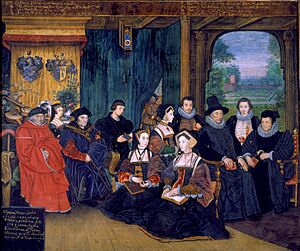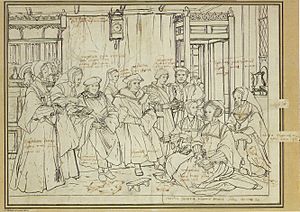Rowland Lockey facts for kids
Rowland Lockey (born around 1565, died 1616) was an English artist. He was both a painter and a goldsmith. Rowland was the son of Leonard Lockey, who made crossbows in London.
When he was young, Rowland Lockey became an apprentice to Nicholas Hilliard. Hilliard was a famous artist who painted tiny portraits called miniatures for Queen Elizabeth I. Lockey trained with Hilliard for eight years, starting in 1581. By 1600, he became a master in the Worshipful Company of Goldsmiths.
Lockey often made copies of older paintings. These copies were popular for decorating the long hallways, called long galleries, in large houses. He also created small, detailed portraits on vellum (a type of treated animal skin). One of his signed works is an engraving for the title page of the 1602 Bishops' Bible.
Contents
Copying Famous Art: The More Family Paintings
Rowland Lockey is most famous for two large copies he made in the early 1590s. These were copies of a painting called The Family of Sir Thomas More by Hans Holbein the Younger. Holbein's original painting from 1527 was sadly lost in a fire many years ago.
Lockey's versions are now in places like Nostell Priory and the National Portrait Gallery in London. His London version, titled Sir Thomas More, his father, his household and his descendants, is quite different. It includes More's family members from later generations, dressed in their clothes from Lockey's time. However, it leaves out some people from Holbein's original painting.
This London painting was likely made around 1593. It was probably ordered by More's grandson, Thomas More II. The painting was a way to celebrate five generations of the family. You can see Thomas More II, his wife, and their two oldest and youngest sons on the right side of the painting. They are wearing ruffs (fancy collars) and holding prayer books.
Interestingly, Anne More, who was Sir Thomas's daughter-in-law, appears twice in the painting. She is shown once as a young woman, copied from Holbein's original. She also appears as an older woman in a painting shown on the back wall.
There is also a smaller, detailed version of this portrait, called a cabinet miniature, from around 1594. It has different details and is also thought to be by Lockey. This miniature is kept at the Victoria and Albert Museum. We also have a drawing by Holbein that helps us know how accurate Lockey's Nostell Priory version is.
Other Works by Rowland Lockey
Lockey also painted other important people. He made a signed portrait of Lady Margaret Beaufort, who was the mother of King Henry VII. This painting was based on an earlier work by Meynnart Wewyck. It was given to St John's College, Cambridge in 1598.
Another painting attributed to Lockey is a portrait of King James I of England when he was a young boy. This painting, now in the National Portrait Gallery, is based on a 1574 work by Arnold Bronckorst.
Lockey worked closely with the Cavendish family, who lived at Hardwick Hall. He was supported by Bess of Hardwick from 1591 to 1597. Later, he worked for her son, Sir William Cavendish, between 1608 and 1613. During this time, Lockey created about forty large paintings, including copies of portraits of Cavendish's ancestors.
An art expert named Sir Roy Strong believed that some less impressive copies of Hilliard's miniature portraits were probably made by Lockey. He noted that these copies had "weak and laboured brushstrokes" and "smudgy" features. Strong thought that Lockey was not as important an artist as Isaac Oliver, who also trained with Hilliard. However, Lockey was important because he helped carry Hilliard's style into the next generation of artists.
Lockey's Artistic Connections
Rowland Lockey had connections with Dutch or Flemish painters who lived in London in the 1580s. For example, a painter named Peter Matheeusen mentioned Lockey in his will in 1588. Matheeusen left gifts to his cousin Adrian Vanson, to the miniaturist Isaac Oliver, and to Rowland Lockey. These gifts included his collection of art instruction books.
See also
- Artists of the Tudor court
- List of British artists






